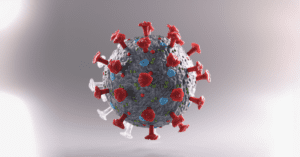
Written by Dr. Hannah K Shorrock
Edited by Dr. Celeste Suart
Three genetic variants in the NPTX1 gene have been linked to cerebellar ataxia, providing a genetic diagnosis for seven families.
Receiving a genetic diagnosis can be incredibly valuable: not only for patients who can access support groups and interact with others with the same disease, but also for the clinicians who care for them and researchers who study similar diseases. Having a genetic diagnosis allows research to be undertaken to understand which cellular pathways are affected by the genetic variant that causes the disease. This research can eventually lead to therapy development: whether that is repurposing compounds that target cellular pathways disrupted in the disease, or identification of new therapeutic approaches to target the root cause – the genetic variant – of the disease. In all cases, this research starts with knowing what causes the disease.
This poses a question: if you have been tested for the known genetic causes of ataxia and do not have any of the known variants, how do clinicians and researchers find out what the genetic cause is?
In the case of NPTX1 variants and ataxia, a research group led by Dr. Stevanin identified a large family with nine affected individuals and set out to understand what caused ataxia in this family. The team looked to see which regions of DNA were the same in all individuals with ataxia in the family. Everyone has slightly different sequences of DNA, this is what makes each of us individual. However, some regions will have more sequence differences and other regions of DNA will have fewer differences. Because of this, we can track regions of DNA that are the same between individuals who have a disease. The areas that are the same are said to be in linkage with the disease. To see if the DNA sequences were the same, the group sequenced the DNA by whole exome sequencing (WES), which sequences all the regions of the genome that make proteins. Through the combination of WES and linkage analysis, the research group found two genetic variants, each in a different gene.
The research group looked at the known functions of these two genes. One of the genes was known to cause a disorder of severe bone fragility. Because these symptoms are very different from the symptoms of the ataxia that the family had, the group decided that this gene was unlikely to be causing the ataxia symptoms of the patients. The other gene, NPTX1, encodes a neuronal protein called NP1 that is released from cells and has various functions at the junctions between two neurons. The group deemed this to be a more likely cause of the ataxia in the family.
To gather more data, they performed a screen of additional ataxia patients. Through this, the group found another 4 families all carrying the same genetic variant in NPTX1. This genetic variant resulted in the 389th amino acid of the protein (p) being changed from a glycine (G) to an arginine (R): this mutation is therefore called p.G389R. One important thing about this glycine amino acid is that it is highly conserved: it is the same across many different species. Each of the 20 standard amino acids used to make the proteins in our body have slightly different characteristics. Some have positive charges, and some have negative charges, some do not interact well with water, and some are quite small while others have bulky additions. If an amino acid is the same across many different species it means that it is important the amino acid has those specific characteristics at that specific position of the protein. This suggests that a different amino acid would impair the function of the protein and so has been selected against during evolution. Hence, if an amino acid is highly conserved it indicates that it is important that the amino acid is, in this case, a glycine, and any alterations from that could impair the protein function.
While screening for NPTX1 genetic variants in other families with ataxia, the research group led by Dr. Stevanin identified another genetic variant in NPTX1 in one family. This variant also affected a highly conserved amino acid, this time changing a glutamate (E) into a glycine (G) at position 327 in the protein: p.E327G. Individuals with the p.E327G and p.G389R variants had late onset ataxia which was slowly progressive. Patients presented with cerebellar atrophy on MR imaging and aspects associated with the cerebellar cognitive affective syndrome. The identification of more than one genetic variant within NPTX1 being linked to ataxia suggests that genetic variants in additional positions of the same gene could also cause ataxia. Indeed, this is what a different research group, led by Dr. Schmidt, found when they reanalyzed the DNA sequencing from a patient with infantile-onset ataxia.
The individual reported by Dr. Schmidt’s team presented with ataxia and cerebellar atrophy as an infant. Based on a clinical diagnosis of suspected genetic ataxia, whole exome sequencing (WES) was performed in 2017 – when the patient was 30 months of age. The analysis of WES at that time did not identify any genetic variants previously linked to ataxia. The initial analysis also failed to identify any new genetic variants in genes known to be associated with ataxia or childhood-onset neurological disorders. Following the publication in 2022 by Dr. Stevanin’s research team that demonstrated variants in NPTX1 can cause adult-onset ataxia, Dr. Schmidt’s team reanalyzed their WES performed in 2017. This analysis revealed that the patient with infantile-onset ataxia had a new, rare genetic variant in NPTX1. Again, this genetic variant affected a highly conserved amino acid with a glutamine (Q) being changed to an arginine (R): p.Q370R. The genetic variant occurred de novo, meaning that neither parent had this genetic variant in NPTX1. This makes sense, as neither parent had childhood-onset ataxia. This is different to both the p.E327G and p.G389R mutations which were identified in families with multiple individuals affected with ataxia indicating a dominant pattern of inheritance.
Between the two research teams led by Dr. Stevanin and Dr. Schmidt, three different genetic variants linked to ataxia were identified, providing a genetic cause for ataxia for individuals from seven different families. But why do these genetic variants in NPTX1 lead to symptoms of ataxia in patients? Dr. Stevanin and their team set out to try and understand this for the p.G389R and the p.E327G variants.
Dr. Stevanin’s team showed that normally the protein encoded by the NPTX1 gene, called NP1, is highly abundant in the Purkinje neurons in the cerebellum. NP1 localizes with a subcellular structure called the endoplasmic reticulum. The endoplasmic reticulum is a cellular compartment that is a major site of protein transport and folding. It is also where some proteins, lipids, and steroids are made. When the group looked at the localization of p.E327G and p.G389R variants of NP1, they also found that they localized to the endoplasmic reticulum. However, the group found that in cells with the variant forms of NP1, the shape of the endoplasmic reticulum was altered. This suggests that the functions of the endoplasmic reticulum could be disrupted by NP1 protein with the p.E327G and p.G389R genetic variants.
At the same time, the group found that both p.E327G and p.G389R caused increased levels of cell death. If we put a few of these findings together we start to build a picture of what might be happening in NPTX1 ataxia. We know from many other types of ataxia that alterations to Purkinje neuron function and death of these neurons are key drivers of disease in ataxia. It therefore becomes quite clear that what we see in NPTX1 ataxia: genetic variants that increase cell death and affect highly conserved amino acids in a protein that is highly expressed in Purkinje neurons; may be likely to cause ataxia. But the question remains: how?
To start to answer this question, the researchers were able to drill down into the effects of the p.E327G variant on NP1 function. As well as localizing to the endoplasmic reticulum, NP1 is normally released from cells. When the researchers looked at NP1 with the p.E327G variant, they found that it was not released from cells. They also found that p.E327G NP1 was also unable to form a complex of proteins normally present in cells. Interestingly, despite not being able to bind to its normal protein partners, NP1 with the p.E327G variant bound to a range of other proteins. The proteins that bind to p.E327G NP1 were primarily associated with the cytoskeleton: the scaffolds that enable cells to maintain their shape. Normal and p.G389R NP1 proteins did not bind to these cytoskeletal proteins. This suggests that the p.E327G genetic variant not only affects the endoplasmic reticulum, but could also be impacting the cytoskeleton as well as preventing the functions of NP1 once it is released from cells.
While the disruption to NP1 release and binding to the cytoskeleton were unique to the p.E327G genetic variant, both p.E327G and p.G389R led to an increase in cell death and disruption of endoplasmic reticulum shape. This suggests that maybe the end goal of both mutations is the same: cell death possibly due to endoplasmic reticulum-associated stress.
Stress in the endoplasmic reticulum has been suggested to be important in other neurological diseases. However, the relevance of the endoplasmic reticulum to ataxia, and its possible role in inducing Purkinje neuron death or dysfunction, remains to be seen. Further research will be needed to understand the intricacies of how these three genetic variants in NPTX1 cause symptoms of ataxia in patients, and whether this disease process is dependent on the role of NP1 in the endoplasmic reticulum.
Key Words
Whole exome sequencing (WES): DNA sequencing of all the regions of the genome that make proteins
Linkage analysis: analyzing if regions of DNA are the same between individuals who have a disease. The areas of DNA that are the same between individuals who have a disease are said to be in linkage with the disease.
Genetic variant: A change in the DNA sequence at a specific position. Genetic variants are the differences in DNA that make us all unique. Some genetic variants are said to be common – present in a large portion of the population. Some genetic variants are rare and only present in a very small proportion of the population, rare genetic variants are more likely to be associated with rare diseases.
Endoplasmic reticulum: a large cellular compartment, or organelle, that has a maze or labyrinth type appearance and is enclosed within a membrane. This means the endoplasmic reticulum is described as a membrane-bound organelle. The endoplasmic reticulum is a major site of protein transport and folding as well as being where some proteins, lipids, and steroids are made, or synthesized.
Conflict of Interest Statement
The author and editor have no conflicts of interest to declare.
Citation of Article Reviewed
Coutelier M, Jacoupy M, Janer A, et al. NPTX1 mutations trigger endoplasmic reticulum stress and cause autosomal dominant cerebellar ataxia. Brain. May 24 2022;145(4):1519-1534. doi:10.1093/brain/awab407
Schoggl J, Siegert S, Boltshauser E, Freilinger M, Schmidt WM. A De Novo Missense NPTX1 Variant in an Individual with Infantile-Onset Cerebellar Ataxia. Mov Disord. Aug 2022;37(8):1774-1776. doi:10.1002/mds.29054
Read Other SCAsource Summary Articles

Los científicos desarrollan un nuevo enfoque para evaluar la Ataxia en casa
Escrito por Ziyang Zhao Editador por la Dra. Hayley McLoughlin Traducido por Ismael Araujo Aliaga Una aplicación para teléfonos inteligentes recientemente desarrollada permitirá a los pacientes evaluar la ataxia en casa. Existe Read More…

The SCA2 Chronicles: Unmasking COVID-19’s impact on Mind and Movement in a Galaxy Not So Far Away
Written by Kaitlyn Neuman Edited by Celeste Suart, PhD Lessons from a global pandemic: COVID-19 negatively impacts speech function and mental health in SCA2 patients. A short time ago, in a Read More…

Online Speech Therapy program helps improve speech in ataxia
Written by Caroline Spencer, PhD Edited by Celeste Suart, PhD ClearSpeechTogether is a virtual group-based speech therapy program for people with speech problems due to progressive ataxia. In this article, researchers Read More…










